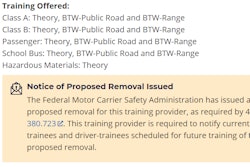Trucking news and briefs for Tuesday, Feb. 15, 2022:
Fuel prices top $4 national average
Another significant increase in diesel prices over the last week have the national average over $4 per gallon for the first time since the week ending March 17, 2014, according to the Department of Energy’s weekly report.
The U.S.’ average for a gallon of on-highway diesel increased 6.8 cents during the week ending Feb. 14, rising to $4.019 per gallon. Since the beginning of 2022, diesel prices have soared, increasing by 40.6 cents in the last six weeks.
Prices increased in all regions across the country last week, with the most significant increase being seen in the Central Atlantic region, where prices jumped by 11.2 cents.
The nation’s most expensive diesel can be found in California at almost $5 per gallon -- $4.994 -- followed by the West Coast less California at $4.261 per gallon.
The cheapest fuel can be found in the Gulf Coast region at $3.785 per gallon, followed by Midwest at $3.884 per gallon.
Prices in other regions, according to DOE, are:
- New England – $4.007
- Central Atlantic – $4.21
- Lower Atlantic – $3.98
- Rocky Mountain – $3.911
ProMiles’ numbers during the same week saw fuel prices increase by 9.7 cents, bringing its national average to $3.834 per gallon.
According to ProMiles’ Fuel Surcharge Index, the most expensive diesel can be found in California at $4.896 per gallon, and the cheapest can be found in the Gulf Coast region at $3.69 per gallon. Fortunately, for now at least, rates seem to be largely keeping pace with fuel's rise on the spot market, as the chart below illustrates.

Electric Kenworth T680E eligible for $120k voucher in California
The zero emissions Kenworth T680E battery-electric truck is eligible for a base $120,000 voucher incentive available to qualifying California purchasers from the California Air Resources Board (CARB).
The incentive is offered through the 2022 CARB Hybrid and Zero-Emission Truck and Bus Voucher Incentive Project (HVIP). In addition, drayage fleets may receive $150,000 vouchers through HVIP toward their Kenworth T680E purchases. The program also offers a 15% Disadvantaged Community (DAC) bonus voucher for qualifying vehicles domiciled in such a designated community.
HVIP is part of California Climate Investments, a statewide initiative that puts billions of Cap-and-Trade dollars to work reducing greenhouse gas emissions, strengthening the economy, and improving public health and the environment particularly in disadvantaged communities. Read more about the program in this related Overdrive reporting from December.
Designed for pickup and delivery, regional haul and drayage applications, the Kenworth T680E is available as a daycab as either a tractor or straight truck in a 6x4 axle configuration. The model is offered in an 82,000-lb. gross vehicle weight rating (GVWR). The T680E is equipped with 536-hp continuous power and up to 670-hp peak power and 1,623 lb.-ft. of torque, with a top speed of 70 mph.
The rig has an estimated operating range of 150 miles, depending on application. The Class 8 battery-electric vehicle utilizes the industry standard SAE CCS1 charge port, can be fully charged in approximately three hours, and features Meritor’s Blue Horizon 14Xe tandem electric powertrain.
[Related: Electric trucks garnering little owner-operator interest, despite growth projections]
DAT to integrate import/export data in rate-analysis product
DAT Freight & Analytics struck an agreement with IHS Market PIERS to add import and export data into DAT iQ’s RateView and Benchmark Analytics reporting. The company says the data will enhance its ability to provide shippers, brokers, carriers and analysts with accurate, comprehensive and actionable freight data.
On average, PIERS analyzes nearly 60,000 bills of lading every day filed with U.S. Customs and Border Protection. The agreement gives DAT access to import and export trade data from 100% of U.S. waterborne port locations in order to provide customers with shipment details down to specific codes and addresses on bills of lading.
“Instead of seeing a general overview of container traffic at any given port, PIERS data tells us precisely how much container volume is arriving at U.S. ports and when," said Claude Pumilia, Data President and CEO. Also: "What’s inside those containers, where those commodities are moving next and how the truckload sector is likely to be impacted.”













